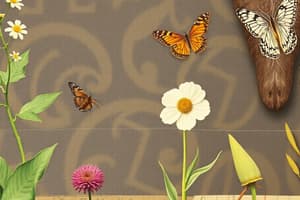Podcast
Questions and Answers
Which of the following is a group of animals that have a backbone?
Which of the following is a group of animals that have a backbone?
- Arthropods
- Mollusks
- Invertebrates (correct)
- Flatworms
What type of animals lay eggs and breathe with lungs or gills?
What type of animals lay eggs and breathe with lungs or gills?
- Reptiles (correct)
- Fish
- Amphibians
- Mammals
Which of the following is a characteristic of arthropods?
Which of the following is a characteristic of arthropods?
- Soft-bodied animals
- Warm-blooded animals
- Animals with jointed legs
- Animals with radial symmetry (correct)
What group of animals includes creatures like jellyfish and corals?
What group of animals includes creatures like jellyfish and corals?
Which group of animals mainly feeds on plants?
Which group of animals mainly feeds on plants?
Study Notes
Classification of Living Things
- Students will match sentences to classify living things into categories: animals, plants, vertebrates, and invertebrates.
- Classification involves identifying characteristics to group living things into specific categories.
Characteristics of Animals
- Amphibians are characterized by their ability to live in both water and on land.
- Birds are characterized by the presence of feathers, wings, and the ability to fly.
- Fish are characterized by their ability to live in water and breathe through gills.
- Mammals are characterized by the presence of hair, milk production, and warm-bloodedness.
- Reptiles are characterized by the presence of scales, laying eggs, and cold-bloodedness.
Invertebrates
- Mollusks are characterized by the presence of a soft, unsegmented body, often with a shell.
- Flatworms are characterized by their flat, soft body and simple organ structure.
- Annelids are characterized by their segmented body and setae (bristles).
- Arthropods are characterized by their jointed limbs, exoskeleton, and segmented body.
- Sponges are characterized by their simple, porous body and lack of organ structure.
More Invertebrates
- Echinoderms are characterized by their radial body symmetry, spiny skin, and water vascular system.
- Cnidarians are characterized by their stinging cells, simple nervous system, and radial body symmetry.
- Arachnids are characterized by their eight legs, simple eyes, and book lungs.
- Centipedes are characterized by their long, segmented body, many legs, and simple eyes.
Types of Feeders
- Herbivores are plants-eaters, feeding on plants and algae.
- Carnivores are meat-eaters, feeding on other animals.
- Omnivores are both plants-eaters and meat-eaters, feeding on a variety of food sources.
- Detritivores are decomposers, feeding on dead and decaying organic matter.
- Scavengers are opportunistic feeders, feeding on carrion and other dead organisms.
Studying That Suits You
Use AI to generate personalized quizzes and flashcards to suit your learning preferences.
Description
This test includes matching sentences with pictures, reading definitions to match with words, and answering questions based on various animal categories like vertebrates, invertebrates, amphibians, birds, fish, mammals, reptiles, mollusks, flatworms, annelids, arthropods, and sponges.




